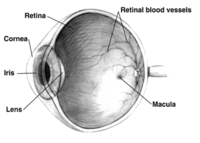
Photo from wikipedia
Aims: This study aimed to investigate the association of mild hypertensive retinopathy with cardiovascular disease (CVD) risk. Methods: A total of 7,027 residents aged 30–79 years without a history of… Click to show full abstract
Aims: This study aimed to investigate the association of mild hypertensive retinopathy with cardiovascular disease (CVD) risk. Methods: A total of 7,027 residents aged 30–79 years without a history of CVD participated in the annual health checkups and retinal photography assessments. Retinal microvascular abnormalities were graded using the standard protocols and classified according to the Keith–Wagener–Barker classification. Mild hypertensive retinopathy was defined as grades 1 and 2. Cox proportional hazard model was used to calculate hazard ratios (HRs) and 95% confidence intervals (CIs) for total CVD and its subtypes according to the presence and absence of mild hypertensive retinopathy. Results: During a median follow-up of 17 years, 351 incident stroke and 247 coronary heart disease (CHD) cases were diagnosed. After adjustment for traditional cardiovascular risk factors, mild hypertensive retinopathy was positively associated with risk of CVD (multivariable HR=1.24; 95% CI, 1.04–1.49) and stroke (1.28; 1.01–1.62) but not with risk of CHD (1.19; 0.89–1.58). Generalized arteriolar narrowing and enhanced arteriolar wall reflex were positively associated with CVD risk, the multivariable HR (95% CI) was 1.24 (1.00–1.54) and 1.33 (1.02–1.74), respectively. Moreover, mild hypertensive retinopathy was positively associated with stroke risk in normotensive participants. Conclusion: Mild hypertensive retinopathy was positively associated with CVD and stroke risk in the urban Japanese population. Especially, generalized arteriolar narrowing and enhanced arteriolar wall reflex were positively associated with CVD risk. These findings suggested that retinal photography could be helpful for cardiovascular risk stratification in the primary cardiovascular prevention.
Journal Title: Journal of Atherosclerosis and Thrombosis
Year Published: 2022
Link to full text (if available)
Share on Social Media: Sign Up to like & get
recommendations!